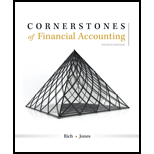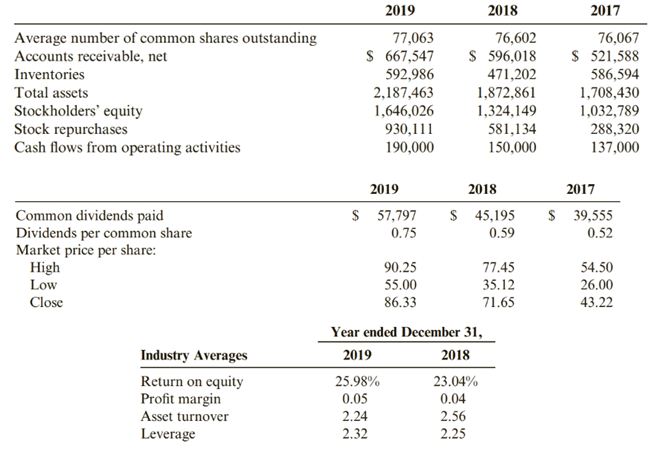
A Preparation of Ratios
Refer to the financial statements for Burch Industries in Problem 12-89A and the following data.

Required:
1. Prepare all the financial ratios for Burch for 2019 and 2018 (using percentage terms where appropriate and rounding all answers to two decimal places).
2. CONCEPTUAL CONNECTION Explain whether Burch’s short-term liquidity is adequate.
3. CONCEPTUAL CONNECTION Discuss whether Burch uses its assets efficiently.
4. CONCEPTUAL CONNECTION Determine whether Burch is profitable.
5. CONCEPTUAL CONNECTION Discuss whether long-term creditors should regard Burch as a high-risk or a low-risk firm.
6. Perform a Dupont analysis (rounding to two decimal places) for 2018 and 2019.
(a)
An organization’s liquidity is its capacity to meet its short-term financial commitments. Liquidity proportions endeavor to quantify an organization’s capacity to satisfy its short-term obligation commitments. This is finished by contrasting an organization’s most fluid resources, those that can be effectively changed over to money, with its short-term liabilities.
To discuss:
Calculate all financial ratio.
Answer to Problem 92PSA
| Ratio | 2019 | 2018 |
| Current ratio | 3.58 | 3.30 |
| Quick ratio | 2.18 | 2.10 |
| Cash ratio | 0.64 | 0.62 |
| Operating cash flow ratio | 0.42 | 0.35 |
| Long-term debt to equity ratio | 0.01 | 0.058 |
| Debt to equity ratio | 0.35 | 0.414 |
| Long-term debt to total assets ratio | 0.007 | 0.041 |
| Debt to Total assets ratio | 0.25 | 0.30 |
| Accounts receivable turnover ratio | 6.22 | 6.09 |
| Inventory turnover ratio | 4.48 | 3.95 |
| Assets turnover ratio | 1.93 | 1.90 |
| Gross profit percentage | 0.40 | 0.386 |
| Return on assets | 0.19 | 0.19 |
| Return on equity | 0.25 | 0.279 |
| Earnings per share ratio | 4.73 | 4.30 |
| Return on common equity | 4.73 | 4.30 |
| Dividend yield ratio | 0.009 | 0.016 |
| Stock repurchase payout ratio | 2.54 | 1.765 |
Explanation of Solution
For 2019
Short-term liquidity ratios
Assets Efficiency ratios
Profitability ratio
Stockholder Ratios
For 2018
Short-term liquidity ratios
Assets Efficiency ratios
Profitability ratio
Stockholder Ratios
(b)
A company’s liquidity is its capacity to meet its short-term money related obligations. Liquidity ratios endeavor to measure a company’s capacity to satisfy its short-term obligation obligations. This is finished by looking at a company’s most fluid assets, those that can be easily changed over to cash, with its short-term liabilities.
To discuss:
Discuss the Short term liquidity.
Answer to Problem 92PSA
As per the company ratio, the company has more cash and company need to investment the extra cash in the market or any other place so company earn more benefit.
Explanation of Solution
Short-term liquidity always be better if the ratio is near about 2:1, 1:1 and like this.
In this company both the year ratio is high which better but not effective for the company its company have more cash so company need to investment the extra cash in the market.
(c)
The benefit turnover ratio is an efficiency ratio that estimates an organization’s capacity to create deals from its advantages by contrasting net deals and normal all out resources. At the end of the day, this ratio demonstrates how productively an organization can utilize its resources for create deals.
To discuss:
Discuss the assets efficiently ratio.
Answer to Problem 92PSA
Company cannot use the assets properly so the ratio is low. The company real need to improve the efficiency of assets for increase the production.
The Company have sufficient assets but company not uses the assets for production.
Explanation of Solution
Higher stock turnover ratios are viewed as a positive pointer of powerful stock administration. Nonetheless, a higher stock turnover ratio improves execution. It in some cases may show lacking stock dimension, which may result in decline in deals.
(d)
Profitability ratios are a class of money related measurements that are utilized to survey a business' capacity to produce income with respect to its income, working costs, accounting report resources, and shareholders' value after some time, utilizing information from a particular point in time.
To discuss:
Discuss the profitability of the company.
Answer to Problem 92PSA
Company have good profitability according to all profitability ratio but the company have more resource to earn income like extra utilization of assets for more production.
Explanation of Solution
The company have sufficient earning from the main business. The company have more benefit which can be use for the production. The company has to more resource of the assets for increase the production.
Right now profitability goods for the company.
(a)
Long Term Debt to Total Asset Ratio is the proportion that speaks to the money related position of the organization and the organization’s capacity to meet all its monetary prerequisites. It demonstrates the level of an organization’s assets that are financed with credits and other monetary commitments that last over a year.
To discuss:
Discuss the long-term creditor as a high risk or low risk.
Answer to Problem 92PSA
Long-term debt ratio is normal in the question because in 2019 the ratio is good but in 2018 the ratio more than 0.40. so the ratio in the 2018 is higher than normal.
Explanation of Solution
It is determined by separating total liabilities by total assets, with higher debt proportions demonstrating higher degrees of debt financing. Regardless of whether a debt proportion is great relies upon the setting inside which it is being broke down. From an unadulterated hazard point of view, lower proportions (0.4 or lower) are viewed as better debt proportions.
(e)
The Dupont analysis sometime called the Dupont display is a monetary proportion dependent on the arrival on value proportion that is utilized to investigate an organization’s capacity to build its arrival on value. As it were, this model separates the arrival on value proportion to clarify how organizations can expand their arrival for speculators.
To calculate:
Calculate the Dupont analysis for 2019 and 2018.
Answer to Problem 92PSA
According to Dupont analysis
| Particular | 2019 | 2018 |
| Return on equity | 0.245 | 0.28 |
Explanation of Solution
For 2019
For 2018
Want to see more full solutions like this?
Chapter 12 Solutions
Cornerstones of Financial Accounting - With CengageNow
- What is the investment turnover for this financial accounting question?arrow_forwardSuppose you take out a five-year car loan for $14000, paying an annual interest rate of 4%. You make monthly payments of $258 for this loan. Complete the table below as you pay off the loan. Months Amount still owed 4% Interest on amount still owed (Remember to divide by 12 for monthly interest) Amount of monthly payment that goes toward paying off the loan (after paying interest) 0 14000 1 2 3 + LO 5 6 7 8 9 10 10 11 12 What is the total amount paid in interest over this first year of the loan?arrow_forwardSuppose you take out a five-year car loan for $12000, paying an annual interest rate of 3%. You make monthly payments of $216 for this loan. mocars Getting started (month 0): Here is how the process works. When you buy the car, right at month 0, you owe the full $12000. Applying the 3% interest to this (3% is "3 per $100" or "0.03 per $1"), you would owe 0.03*$12000 = $360 for the year. Since this is a monthly loan, we divide this by 12 to find the interest payment of $30 for the month. You pay $216 for the month, so $30 of your payment goes toward interest (and is never seen again...), and (216-30) = $186 pays down your loan. (Month 1): You just paid down $186 off your loan, so you now owe $11814 for the car. Using a similar process, you would owe 0.03* $11814 = $354.42 for the year, so (dividing by 12), you owe $29.54 in interest for the month. This means that of your $216 monthly payment, $29.54 goes toward interest and $186.46 pays down your loan. The values from above are included…arrow_forward
- Suppose you have an investment account that earns an annual 9% interest rate, compounded monthly. It took $500 to open the account, so your opening balance is $500. You choose to make fixed monthly payments of $230 to the account each month. Complete the table below to track your savings growth. Months Amount in account (Principal) 9% Interest gained (Remember to divide by 12 for monthly interest) Monthly Payment 1 2 3 $500 $230 $230 $230 $230 + $230 $230 10 6 $230 $230 8 9 $230 $230 10 $230 11 $230 12 What is the total amount gained in interest over this first year of this investment plan?arrow_forwardGiven correct answer general Accounting questionarrow_forwardFinancial accounting questionarrow_forward
- General accountingarrow_forwardHii expert please given correct answer general Accounting questionarrow_forwardOn 1st May, 2024 you are engaged to audit the financial statement of Giant Pharmacy for the period ending 30th December 2023. The Pharmacy is located at Mgeni Nani at the outskirts of Mtoni Kijichi in Dar es Salaam City. Materiality is judged to be TZS. 200,000/=. During the audit you found that all tests produced clean results. As a matter of procedures you drafted an audit report with an unmodified opinion to be signed by the engagement partner. The audit partner reviewed your file in October, 2024 and concluded that your audit complied with all requirements of the international standards on auditing and that; sufficient appropriate audit evidence was in the file to support a clean audit opinion. Subsequently, an audit report with an unmodified opinion was issued on 1st November, 2024. On 18th January 2025, you receive a letter from Dr. Fatma Shemweta, the Executive Director of the pharmacy informing you that their cashier who has just absconded has been arrested in Kigoma with TZS.…arrow_forward
 Financial AccountingAccountingISBN:9781337272124Author:Carl Warren, James M. Reeve, Jonathan DuchacPublisher:Cengage Learning
Financial AccountingAccountingISBN:9781337272124Author:Carl Warren, James M. Reeve, Jonathan DuchacPublisher:Cengage Learning- Century 21 Accounting Multicolumn JournalAccountingISBN:9781337679503Author:GilbertsonPublisher:Cengage
 Intermediate Financial Management (MindTap Course...FinanceISBN:9781337395083Author:Eugene F. Brigham, Phillip R. DavesPublisher:Cengage Learning
Intermediate Financial Management (MindTap Course...FinanceISBN:9781337395083Author:Eugene F. Brigham, Phillip R. DavesPublisher:Cengage Learning




